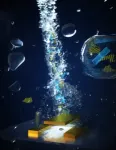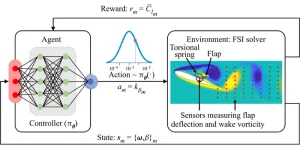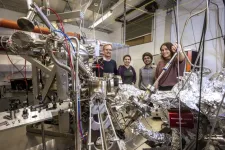(Press-News.org) DURHAM, N.C. – Engineers at Duke University have produced the world’s first fully recyclable printed electronics that replace the use of chemicals with water in the fabrication process. By bypassing the need for hazardous chemicals, the demonstration points down a path industry could follow to reduce its environmental footprint and human health risks.
The research appeared online Feb. 28 in the journal Nano Letters.
One of the dominant challenges facing any electronics manufacturer is successfully securing several layers of components on top of each other, which is crucial to making complex devices. Getting these layers to stick together can be a frustrating process, particularly for printed electronics.
“If you’re making a peanut butter and jelly sandwich, one layer on either slice of bread is easy,” explained Aaron Franklin, the Addy Professor of Electrical and Computer Engineering at Duke, who led the study. “But if you put the jelly down first and then try to spread peanut butter on top of it, forget it, the jelly won’t stay put and will intermix with the peanut butter. Putting layers on top of each other is not as easy as putting them down on their own — but that’s what you have to do if you want to build electronic devices with printing.”
In previous work, Franklin and his group demonstrated the first fully recyclable printed electronics. The devices used three carbon-based inks: semiconducting carbon nanotubes, conductive graphene and insulating nanocellulose. In trying to adapt the original process to only use water, the carbon nanotubes presented the largest challenge.
To make a water-based ink in which the carbon nanotubes don’t clump together and spread evenly on a surface, a surfactant similar to detergent is added. The resulting ink, however, does not create a layer of carbon nanotubes dense enough for a high current of electrons to travel across.
“You want the carbon nanotubes to look like al dente spaghetti strewn down on a flat surface,” said Franklin. “But with a water-based ink, they look more like they’ve been taken one-by-one and tossed on a wall to check for doneness. If we were using chemicals, we could just print multiple passes again and again until there were enough nanotubes. But water doesn’t work that way. We could do it 100 times and there’d still be the same density as the first time.”
This is because the surfactant used to keep the carbon nanotubes from clumping also prevents additional layers from adhering to the first. In a traditional manufacturing process, these surfactants would be removed using either very high temperatures, which takes a lot of energy, or harsh chemicals, which can pose human and environmental health risks. Franklin and his group wanted to avoid both.
In the paper, Franklin and his group develop a cyclical process in which the device is rinsed with water, dried in relatively low heat and printed on again. When the amount of surfactant used in the ink is also tuned down, the researchers show that their inks and processes can create fully functional, fully recyclable, fully water-based transistors.
Compared to a resistor or capacitor, a transistor is a relatively complex computer component used in devices such as power control or logic circuits and sensors. Franklin explains that, by demonstrating a transistor first, he hopes to signal to the rest of the field that there is a viable path toward making some electronics manufacturing processes much more environmentally friendly.
Franklin has already proven that nearly 100% of the carbon nanotubes and graphene used in printing can be recovered and reused in the same process, losing very little of the substances or their performance viability. Because nanocellulose is made from wood, it can simply be recycled or biodegraded like paper. And while the process does use a lot of water, it’s not nearly as much as what is required to deal with the toxic chemicals used in traditional fabrication methods.
According to a United Nations estimate, less than a quarter of the millions of pounds of electronics thrown away each year is recycled. And the problem is only going to get worse as the world eventually upgrades to 6G devices and the Internet of Things (IoT) continues to expand. So any dent that could be made in this growing mountain of electronic trash is important to pursue.
While more work needs to be done, Franklin says the approach could be used in the manufacturing of other electronic components like the screens and displays that are now ubiquitous to society. Every electronic display has a backplane of thin-film transistors similar to what is demonstrated in the paper. The current fabrication technology is high-energy and relies on hazardous chemicals as well as toxic gasses. The entire industry has been flagged for immediate attention by the US Environmental Protection Agency. [https://www.epa.gov/climateleadership/sector-spotlight-electronics]
“The performance of our thin-film transistors doesn’t match the best currently being manufactured, but they’re competitive enough to show the research community that we should all be doing more work to make these processes more environmentally friendly,” Franklin said.
This work was supported by the National Institutes of Health (1R01HL146849), the Air Force Office of Scientific Research (FA9550-22-1-0466), and the National Science Foundation (ECCS-1542015, Graduate Research Fellowship 2139754).
CITATION: “All-Carbon Thin-Film Transistors Using Water-Only Printing,” Shiheng Lu, Brittany N. Smith, Hope Meikle, Michael J. Therien, and Aaron D. Franklin. Nano Letters, Feb. 28, 2023. DOI: 10.1021/acs.nanolett.2c04196
# # #
END
Fully recyclable printed electronics ditch toxic chemicals for water
First-of-its-kind demonstration suggests a more environmentally friendly future for the electronics industry is possible
2023-04-06
ELSE PRESS RELEASES FROM THIS DATE:
Model simulates variable flap stiffness for the best lift
2023-04-06
There is extensive research on how a fixed-position flap affects lift in the realm of fluid-structure interaction. However, taking the conversation in a new direction, researchers at the University of Illinois Urbana-Champaign conducted a bio-inspired study with a novel twist—variable stiffness—to learn more about how it affects lift.
The researchers wondered if they could model a flap on an airfoil, or wing, with varying stiffnesses over time much like a bird can tense, or stiffen, the musculature and tendons connected to covert feathers.
“We know from previous studies ...
Broccoli consumption protects gut lining, reduces disease, in mice
2023-04-06
UNIVERSITY PARK, Pa. — Broccoli is known to be beneficial to our health. For example, research has shown that increased consumption of the cruciferous vegetable decreases incidences of cancer and type 2 diabetes. In a recent study, researchers at Penn State found that broccoli contains certain molecules that bind to a receptor within mice and help to protect the lining of the small intestine, thereby inhibiting the development of disease. The findings lend support to the idea that broccoli truly is a ‘superfood.’
“We ...
UNLV, SNWA study makes case for Candida auris wastewater surveillance
2023-04-06
A rapid spike in cases of a potentially deadly, drug-resistant fungus has concerned public health officials across the nation. But a team of Southern Nevada researchers hope their new study applying wastewater surveillance can help health officials get a step ahead of this emerging global public health threat.
The Pathogen Problem
Candida auris is a fungus that can cause serious infections, particularly in patients who are immunocompromised, have pre-existing health conditions, are in long-term healthcare settings, or are undergoing treatment with invasive medical devices such as a catheter. Infection prevention ...
Giving pregnant women routine third trimester ultrasound scans could reduce rates of undetected breech pregnancy by 71%, enabling better care before and during labor and improved outcomes for newborns
2023-04-06
Giving pregnant women routine third trimester ultrasound scans could reduce rates of undetected breech pregnancy by 71%, enabling better care before and during labor and improved outcomes for newborns
In your coverage, please use this URL to provide access to the freely available paper in PLOS Medicine: http://journals.plos.org/plosmedicine/article?id=10.1371/journal.pmed.1004192
Article Title: Impact of point-of-care ultrasound and routine third trimester ultrasound on undiagnosed breech presentation and perinatal outcomes: An observational multicentre cohort study
Author Countries: United Kingdom, Turkey
Funding: The author(s) received no specific funding for this work. END ...
Implant treats dangerously low blood pressure in people with spinal cord injury
2023-04-06
An implant that delivers electrical stimulation to a select group of spinal neurons can treat dangerously low blood pressure in people with spinal cord injuries, addressing an often “invisible” consequence of paralysis.
For his work in developing this treatment, called the neuroprosthetic baroreflex, Jordan W. Squair is the winner of the 2023 BioInnovation Institute & Science Prize for Innovation. The prize seeks to reward scientists who deliver research at the intersection of the life sciences and entrepreneurship.
“Dr. Squair’s prize-winning research on epidural electrical stimulation restores blood pressure control in patients ...
Editorial: Share SARS-CoV-2 data immediately
2023-04-06
In an editorial, Maria Van Kerkhove – who serves as the technical lead for the COVID-19 response at the World Health Organization (WHO) – outlines how earlier this month (March 2023), WHO learned that scientists in China possessed data on viral samples from Wuhan that had been gathered in January 2020. “These should have been shared immediately—not 3 years later,” she writes. “The lack of data disclosure is simply inexcusable.” WHO continues to call on China and all countries to share any data on the origins of SARS-CoV-2 immediately. “China has advanced technical capabilities,” Van ...
Uncovered: A new mode of reproduction that produces chimeric males in yellow crazy ants
2023-04-06
Male yellow crazy ants (Anoplolepis gracilipes) are chimeras of two separate genetic lineages, researchers report in a study that reveals a unique mode of reproduction in this species – one previously unknown to science. While most multicellular organisms develop from a single-cell zygote into a collection of genetically identical cells – a hallmark of biological inheritance – the new findings show that yellow crazy ants deviate from this expectation. According to the study, all male yellow crazy ants are instead composed ...
Bushmeat consumption unchanged by COVID-19 in Kenya and Tanzania border towns, new study reveals
2023-04-06
First ever study looking at disease risks of wild meat activities in rural communities.
Nearly 70% of rural respondents at Kenya-Tanzania border said that COVID-19 did not impact their levels of wild meat consumption, with some even reporting increased consumption.
Ungulates were found to be the most consumed species, followed by birds, rodents and shrews.
Governments need to focus on better controlling zoonotic disease transmission risks through community engagements on behavior change interventions, improving hygiene and standards of informal markets, supporting wildlife conservation ...
Methyl groups enhance key properties of PHA plastics and enable closed-loop recyclability
2023-04-06
A class of polyesters considered a promising alternative to common plastics, were it not for limitations like brittleness and thermal instability, have now been made more mechanically tough and thermally stable. Researchers replaced the reactive hydrogens in the monomer of these materials – polyhydroxyalkanoate (PHA) plastics – and found it enhanced PHA thermal and mechanical properties and enabled closed-loop chemical recyclability. The new approach could provide a route for increased use of sustainable PHA plastics. ...
Ultra-fast light at the end of the vacuum tunnel: Meta-optics shows physical processes in the attosecond range
2023-04-06
Developed at Harvard, and successfully tested at Graz University of Technology (TU Graz), a revolutionary new meta-optics for microscopes with extremely high spatial and temporal resolution has proven its functional ability in laboratory tests at the Institute of Experimental Physics at TU Graz. Microscopes using this kind of lens promise completely new research and development approaches, especially in semiconductor and solar cell technology. The research team from Graz and Boston currently reports on the construction and the successful laboratory experiment with this new meta-optics in the specialist journal Science.
The lens of ...
LAST 30 PRESS RELEASES:
Sleeping in on weekends may help boost teens’ mental health
Study: Teens use cellphones for an hour a day at school
After more than two years of war, Palestinian children are hungry, denied education and “like the living dead”
The untold story of life with Prader-Willi syndrome - according to the siblings who live it
How the parasite that ‘gave up sex’ found more hosts – and why its victory won’t last
When is it time to jump? The boiling frog problem of AI use in physics education
Twitter data reveals partisan divide in understanding why pollen season's getting worse
AI is quick but risky for updating old software
Revolutionizing biosecurity: new multi-omics framework to transform invasive species management
From ancient herb to modern medicine: new review unveils the multi-targeted healing potential of Borago officinalis
Building a global scientific community: Biological Diversity Journal announces dual recruitment of Editorial Board and Youth Editorial Board members
Microbes that break down antibiotics help protect ecosystems under drug pollution
Smart biochar that remembers pollutants offers a new way to clean water and recycle biomass
Rice genes matter more than domestication in shaping plant microbiomes
Ticking time bomb: Some farmers report as many as 70 tick encounters over a 6-month period
Turning garden and crop waste into plastics
Scientists discover ‘platypus galaxies’ in the early universe
Seeing thyroid cancer in a new light: when AI meets label-free imaging in the operating room
Neutrophil-to-lymphocyte ratio may aid risk stratification in depressive disorder
2026 Seismological Society of America Annual Meeting
AI-powered ECG analysis offers promising path for early detection of chronic obstructive pulmonary disease, says Mount Sinai researchers
GIMM uncovers flaws in lab-grown heart cells and paves the way for improved treatments
Cracking the evolutionary code of sleep
Medications could help the aging brain cope with surgery, memory impairment
Back pain linked to worse sleep years later in men over 65, according to study
CDC urges ‘shared decision-making’ on some childhood vaccines; many unclear about what that means
New research finds that an ‘equal treatment’ approach to economic opportunity advertising can backfire
Researchers create shape-shifting, self-navigating microparticles
Science army mobilizes to map US soil microbiome
Researchers develop new tools to turn grain crops into biosensors
[Press-News.org] Fully recyclable printed electronics ditch toxic chemicals for waterFirst-of-its-kind demonstration suggests a more environmentally friendly future for the electronics industry is possible





